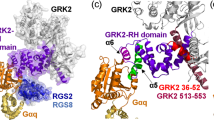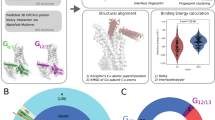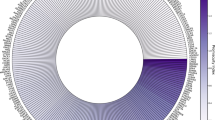Abstract
The diverse Regulator of G protein Signaling (RGS) family sets the timing of G protein signaling. To understand how the structure of RGS proteins determines their common ability to inactivate G proteins and their selective G protein recognition, we combined structure-based energy calculations with biochemical measurements of RGS activity. We found a previously unidentified group of variable 'Modulatory' residues that reside at the periphery of the RGS domain–G protein interface and fine-tune G protein recognition. Mutations of Modulatory residues in high-activity RGS proteins impaired RGS function, whereas redesign of low-activity RGS proteins in critical Modulatory positions yielded complete gain of function. Therefore, RGS proteins combine a conserved core interface with peripheral Modulatory residues to selectively optimize G protein recognition and inactivation. Finally, we show that our approach can be extended to analyze interaction specificity across other large protein families.
This is a preview of subscription content, access via your institution
Access options
Subscribe to this journal
Receive 12 print issues and online access
$189.00 per year
only $15.75 per issue
Buy this article
- Purchase on Springer Link
- Instant access to full article PDF
Prices may be subject to local taxes which are calculated during checkout







Similar content being viewed by others
References
Siderovski, D.P., Hessel, A., Chung, S., Mak, T.W. & Tyers, M. A new family of regulators of G-protein-coupled receptors? Curr. Biol. 6, 211–212 (1996).
Koelle, M.R. & Horvitz, H.R. EGL-10 regulates G protein signaling in the C. elegans nervous system and shares a conserved domain with many mammalian proteins. Cell 84, 115–125 (1996).
Berman, D.M., Wikie, T.M. & Gilman, A.G. GAIP and RGS4 are GTPase-activating proteins for the Gi subfamily of G protein α subunits. Cell 86, 445–452 (1996).
Hunt, T.W., Fields, T.A., Casey, P.J. & Peralta, E.G. RGS10 is a selective activator of Gαi GTPase activity. Nature 383, 175–177 (1996).
Watson, N., Linder, M.E., Druey, K.M., Kehrl, J.H. & Blumer, K.J. RGS family members: GTPase-activating proteins for heterotrimeric G-protein α-subunits. Nature 383, 172–175 (1996).
Ross, E.M. & Wilkie, T.M. GTPase-activating proteins for heterotrimeric G proteins: regulators of G protein signaling (RGS) and RGS-like proteins. Annu. Rev. Biochem. 69, 795–827 (2000).
Hollinger, S. & Hepler, J.R. Cellular regulation of RGS proteins: modulators and integrators of G protein signaling. Pharmacol. Rev. 54, 527–559 (2002).
Neubig, R.R. & Siderovski, D.P. Regulators of G-protein signalling as new central nervous system drug targets. Nat. Rev. Drug Discov. 1, 187–197 (2002).
Neitzel, K.L. & Hepler, J.R. Cellular mechanisms that determine selective RGS protein regulation of G protein-coupled receptor signaling. Semin. Cell Dev. Biol. 17, 383–389 (2006).
Hurst, J.H. & Hooks, S.B. Regulator of G-protein signaling (RGS) proteins in cancer biology. Biochem. Pharmacol. 78, 1289–1297 (2009).
Wang, Q., Liu, M., Mullah, B., Siderovski, D.P. & Neubig, R.R. Receptor-selective effects of endogenous RGS3 and RGS5 to regulate mitogen-activated protein kinase activation in rat vascular smooth muscle cells. J. Biol. Chem. 277, 24949–24958 (2002).
Tang, K.M. et al. Regulator of G-protein signaling-2 mediates vascular smooth muscle relaxation and blood pressure. Nat. Med. 9, 1506–1512 (2003).
Xie, G.X. & Palmer, P.P. How regulators of G protein signaling achieve selective regulation. J. Mol. Biol. 366, 349–365 (2007).
Cifelli, C. et al. RGS4 regulates parasympathetic signaling and heart rate control in the sinoatrial node. Circ. Res. 103, 527–535 (2008).
Bansal, G., Druey, K.M. & Xie, Z. R4 RGS proteins: regulation of G-protein signaling and beyond. Pharmacol. Ther. 116, 473–495 (2007).
Bansal, G., Xie, Z., Rao, S., Nocka, K.H. & Druey, K.M. Suppression of immunoglobulin E-mediated allergic responses by regulator of G protein signaling 13. Nat. Immunol. 9, 73–80 (2008).
Laroche, G., Giguere, P.M., Roth, B.L., Trejo, J. & Siderovski, D.P. RNA interference screen for RGS protein specificity at muscarinic and protease-activated receptors reveals bidirectional modulation of signaling. Am. J. Physiol. Cell Physiol. 299, C654–C664 (2010).
Sowa, M.E. et al. Prediction and confirmation of a site critical for effector regulation of RGS domain activity. Nat. Struct. Biol. 8, 234–237 (2001).
Martemyanov, K.A. & Arshavsky, V.Y. Biology and functions of the RGS9 isoforms. Prog. Mol. Biol. Transl. Sci. 86, 205–227 (2009).
Skiba, N.P., Hopp, J.A. & Arshavsky, V.Y. The effector enzyme regulates the duration of G protein signaling in vertebrate photoreceptors by increasing the affinity between transducin and RGS protein. J. Biol. Chem. 275, 32716–32720 (2000).
Heximer, S.P., Watson, N., Linder, M.E., Blumer, K.J. & Hepler, J.R. RGS2/G0S8 is a selective inhibitor of Gqα function. Proc. Natl. Acad. Sci. USA 94, 14389–14393 (1997).
Heximer, S.P. et al. G protein selectivity is a determinant of RGS2 function. J. Biol. Chem. 274, 34253–34259 (1999).
Ingi, T. et al. Dynamic regulation of RGS2 suggests a novel mechanism in G-protein signaling and neuronal plasticity. J. Neurosci. 18, 7178–7188 (1998).
Tesmer, J.J., Berman, D.M., Gilman, A.G. & Sprang, S.R. Structure of RGS4 bound to AlF4–activated Giα1: stabilization of the transition state for GTP hydrolysis. Cell 89, 251–261 (1997).
Kimple, A.J. et al. Structural determinants of G-protein α subunit selectivity by regulator of G-protein signaling 2 (RGS2). J. Biol. Chem. 284, 19402–19411 (2009).
Slep, K.C. et al. Structural determinants for regulation of phosphodiesterase by a G protein at 2.0 A. Nature 409, 1071–1077 (2001).
Soundararajan, M. et al. Structural diversity in the RGS domain and its interaction with heterotrimeric G protein α-subunits. Proc. Natl. Acad. Sci. USA 105, 6457–6462 (2008).
Slep, K.C. et al. Molecular architecture of Gαo and the structural basis for RGS16-mediated deactivation. Proc. Natl. Acad. Sci. USA 105, 6243–6248 (2008).
Posner, B.A., Mukhopadhyay, S., Tesmer, J.J., Gilman, A.G. & Ross, E.M. Modulation of the affinity and selectivity of RGS protein interaction with G α subunits by a conserved asparagine/serine residue. Biochemistry 38, 7773–7779 (1999).
Kosloff, M. & Selinger, Z. GTPase catalysis by Ras and other G-proteins: insights from Substrate Directed SuperImposition. J. Mol. Biol. 331, 1157–1170 (2003).
Sprang, S.R., Chen, Z. & Du, X. Structural basis of effector regulation and signal termination in heterotrimeric Gα proteins. Adv. Protein Chem. 74, 1–65 (2007).
Sowa, M.E., He, W., Wensel, T.G. & Lichtarge, O. A regulator of G protein signaling interaction surface linked to effector specificity. Proc. Natl. Acad. Sci. USA 97, 1483–1488 (2000).
Siderovski, D.P. & Willard, F.S. The GAPs, GEFs, and GDIs of heterotrimeric G-protein α subunits. Int. J. Biol. Sci. 1, 51–66 (2005).
Sheinerman, F.B., Al-Lazikani, B. & Honig, B. Sequence, structure and energetic determinants of phosphopeptide selectivity of SH2 domains. J. Mol. Biol. 334, 823–841 (2003).
Sheinerman, F.B. & Honig, B. On the role of electrostatic interactions in the design of protein-protein interfaces. J. Mol. Biol. 318, 161–177 (2002).
Srinivasa, S.P., Watson, N., Overton, M.C. & Blumer, K.J. Mechanism of RGS4, a GTPase-activating protein for G protein α subunits. J. Biol. Chem. 273, 1529–1533 (1998).
Natochin, M., McEntaffer, R.L. & Artemyev, N.O. Mutational analysis of the Asn residue essential for RGS protein binding to G-proteins. J. Biol. Chem. 273, 6731–6735 (1998).
Wieland, T., Bahtijari, N., Zhou, X.B., Kleuss, C. & Simon, M.I. Polarity exchange at the interface of regulators of G protein signaling with G protein α-subunits. J. Biol. Chem. 275, 28500–28506 (2000).
Kortemme, T. & Baker, D. A simple physical model for binding energy hot spots in protein-protein complexes. Proc. Natl. Acad. Sci. USA 99, 14116–14121 (2002).
Ashkenazy, H., Erez, E., Martz, E., Pupko, T. & Ben-Tal, N. ConSurf 2010: calculating evolutionary conservation in sequence and structure of proteins and nucleic acids. Nucleic Acids Res. 38, W529–W533 (2010).
Kühlmann, U.C., Pommer, A.J., Moore, G.R., James, R. & Kleanthous, C. Specificity in protein-protein interactions: the structural basis for dual recognition in endonuclease colicin-immunity protein complexes. J. Mol. Biol. 301, 1163–1178 (2000).
Schreiber, G. & Keating, A.E. Protein binding specificity versus promiscuity. Curr. Opin. Struct. Biol. 21, 50–61 (2010).
Kortemme, T. et al. Computational redesign of protein-protein interaction specificity. Nat. Struct. Mol. Biol. 11, 371–379 (2004).
Joachimiak, L.A., Kortemme, T., Stoddard, B.L. & Baker, D. Computational design of a new hydrogen bond network and at least a 300-fold specificity switch at a protein-protein interface. J. Mol. Biol. 361, 195–208 (2006).
Mandell, D.J. & Kortemme, T. Computer-aided design of functional protein interactions. Nat. Chem. Biol. 5, 797–807 (2009).
Levin, K.B. et al. Following evolutionary paths to protein-protein interactions with high affinity and selectivity. Nat. Struct. Mol. Biol. 16, 1049–1055 (2009).
Li, W. et al. Highly discriminating protein-protein interaction specificities in the context of a conserved binding energy hotspot. J. Mol. Biol. 337, 743–759 (2004).
Lippow, S.M., Wittrup, K.D. & Tidor, B. Computational design of antibody-affinity improvement beyond in vivo maturation. Nat. Biotechnol. 25, 1171–1176 (2007).
Skerker, J.M. et al. Rewiring the specificity of two-component signal transduction systems. Cell 133, 1043–1054 (2008).
Grigoryan, G., Reinke, A.W. & Keating, A.E. Design of protein-interaction specificity gives selective bZIP-binding peptides. Nature 458, 859–864 (2009).
Karanicolas, J. & Kuhlman, B. Computational design of affinity and specificity at protein-protein interfaces. Curr. Opin. Struct. Biol. 19, 458–463 (2009).
Edwards, A. Large-scale structural biology of the human proteome. Annu. Rev. Biochem. 78, 541–568 (2009).
Doudeva, L.G. et al. Crystal structural analysis and metal-dependent stability and activity studies of the ColE7 endonuclease domain in complex with DNA/Zn2+ or inhibitor/Ni2+. Protein Sci. 15, 269–280 (2006).
Ko, T.P., Liao, C.C., Ku, W.Y., Chak, K.F. & Yuan, H.S. The crystal structure of the DNase domain of colicin E7 in complex with its inhibitor Im7 protein. Structure 7, 91–102 (1999).
Huang, H. & Yuan, H.S. The conserved asparagine in the HNH motif serves an important structural role in metal finger endonucleases. J. Mol. Biol. 368, 812–821 (2007).
Petrey, D. et al. Using multiple structure alignments, fast model building, and energetic analysis in fold recognition and homology modeling. Proteins 53 (Suppl. 6) 430–435 (2003).
Xiang, Z. & Honig, B. Extending the accuracy limits of prediction for side-chain conformations. J. Mol. Biol. 311, 421–430 (2001).
MacKerell, A.D. et al. All-atom empirical potential for molecular modeling and dynamics studies of proteins. J. Phys. Chem. B 102, 3586–3616 (1998).
Honig, B. & Nicholls, A. Classical electrostatics in biology and chemistry. Science 268, 1144–1149 (1995).
Sridharan, S., Nicholls, A. & Honig, B. A new vertex algorithm to calculate solvent accessible surface areas. FASEB J. 6, A174 (1992).
Acknowledgements
This research was supported by US National Institutes of Health grants EY012859 (V.Y.A.) and GM082892 (D.P.S.), by a core grant for vision research to Duke University (EY5722), by the US National Science Foundation through TeraGrid resources (TG-MCB080085T; M.K.) and by a long-term postdoctoral fellowship from the Human Frontier Science Program (M.K.). We thank the Duke Shared Cluster Resource and the San Diego Supercomputer Center for computational resources, S.A. Baker, S. Farsiu, N.P. Skiba, E.S. Lobanova and D. Reichmann for helpful suggestions, B. Honig for insightful guidance (M.K.) and F. Sheinerman, R. Rohs, S. Fleishman and E. Alexov for helpful discussions.
Author information
Authors and Affiliations
Contributions
M.K. designed and carried out computational analysis and biochemical experiments, analyzed data and prepared the manuscript, A.M.T. carried out experiments and prepared the manuscript, D.E.B. carried out experiments and prepared the manuscript, D.P.S. supervised the project and prepared the manuscript and V.Y.A. supervised the project and analysis and prepared the manuscript.
Corresponding author
Ethics declarations
Competing interests
The authors declare no competing financial interests.
Supplementary information
Supplementary Text and Figures
Supplementary Figures 1–4, Supplementary Tables 1 and 2, and Supplementary Methods (PDF 620 kb)
Rights and permissions
About this article
Cite this article
Kosloff, M., Travis, A., Bosch, D. et al. Integrating energy calculations with functional assays to decipher the specificity of G protein–RGS protein interactions. Nat Struct Mol Biol 18, 846–853 (2011). https://doi.org/10.1038/nsmb.2068
Received:
Accepted:
Published:
Issue Date:
DOI: https://doi.org/10.1038/nsmb.2068
This article is cited by
-
Primary sequence based protein–protein interaction binder generation with transformers
Complex & Intelligent Systems (2024)
-
Structural design principles for specific ultra-high affinity interactions between colicins/pyocins and immunity proteins
Scientific Reports (2021)
-
Residue-level determinants of RGS R4 subfamily GAP activity and specificity towards the Gi subfamily
Cellular and Molecular Life Sciences (2021)
-
Structural design principles that underlie the multi-specific interactions of Gαq with dissimilar partners
Scientific Reports (2019)
-
Structure based energy calculation to determine the regulation of G protein signalling by RGS and RGS-G protein interaction specificity
Interdisciplinary Sciences: Computational Life Sciences (2012)



